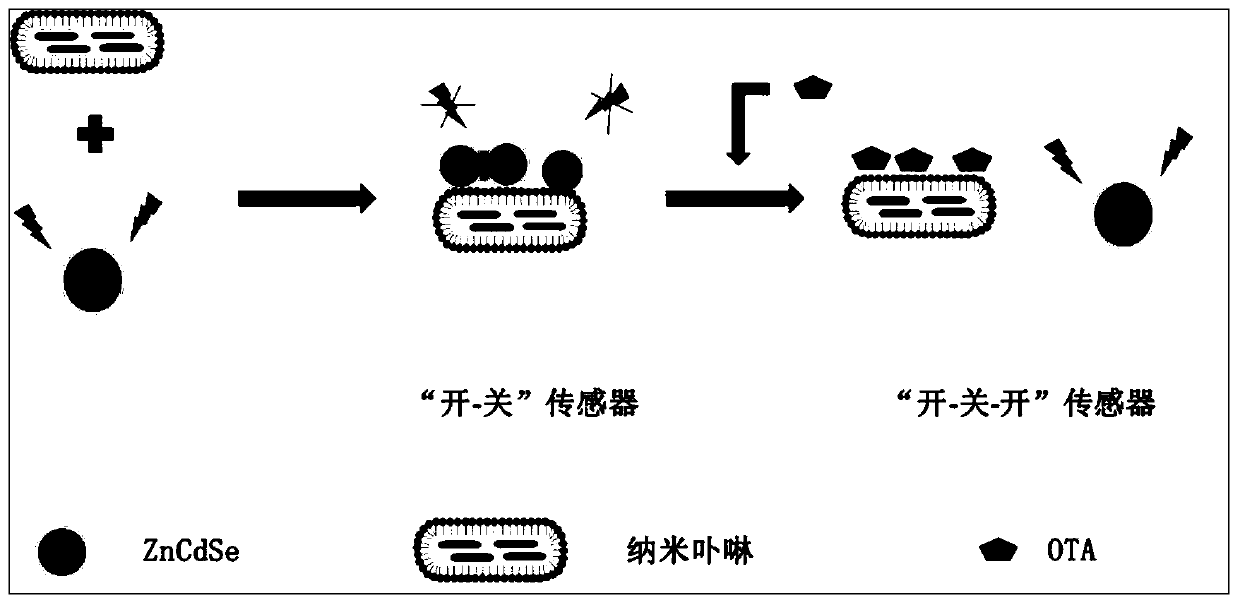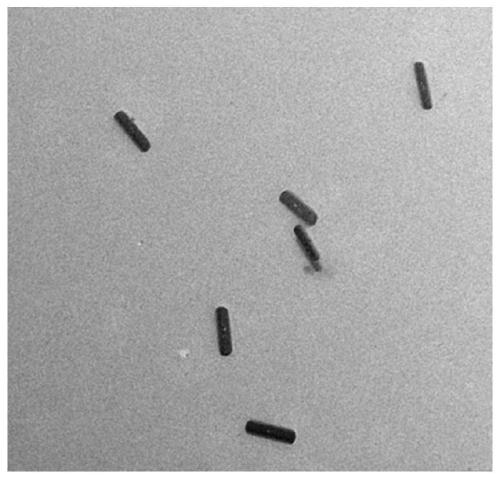Preparation method and application of a fluorescence sensor for detecting ochratoxin A
A fluorescent sensor, ochratoxin technology, applied in chemical instruments and methods, fluorescence/phosphorescence, nano-optics, etc., can solve the problems of limited practical application, technical labor, time-consuming, etc., and achieve fast response, high sensitivity, and stability good sex effect
- Summary
- Abstract
- Description
- Claims
- Application Information
AI Technical Summary
Problems solved by technology
Method used
Image
Examples
Embodiment 1
[0044] The preparation of a kind of fluorescent sensor that detects ochratoxin A is mainly divided into following four steps (see figure 1 ):
[0045] (1) The first step, the synthesis of ZnCdSe quantum dots
[0046] Dissolve zinc chloride (0.035g, 0.25mmol) and N-acetyl-L-cysteine (0.1253g, 0.76mmol) in 40mL of ultrapure water, and stir for 20 minutes at normal pressure and low temperature (5°C) . After stirring, adjust the pH to 9.7 with sodium hydroxide solution (0.1 mol / L). After the pH was adjusted, cadmium dichloride (0.58mg, 0.0025mmol) was added, then filled with nitrogen and stirred in an ice bath for 15 minutes. Sodium selenium hydride (0.0026 g, 0.025 mmol) was injected into the mixture, and the mixture was filled with nitrogen and stirred in an ice bath for 15 minutes. After the reaction was completed, the solution was transferred to a reaction kettle and reacted in an oven at 200° C. for 65 minutes. The resulting concentration is 4.2×10 -7 mol / L ZnCdSe qua...
Embodiment 2
[0055] Example 2 Determination of OTA in milk by a novel fluorescent sensor
[0056] (1) Preparation of samples to be tested
[0057] Take 1.5ml of milk, add OTA standard, and then add acetonitrile to make the total volume 5mL, and configure samples with concentrations of (2, 6, 30, 60ng / mL).
[0058] (two) the synthesis of ZnCdSe quantum dot fluorescent probe, with embodiment 1
[0059] (3) Synthesis of four-(4-pyridyl) zinc porphyrin nanorod self-assembly solution, same as in Example 1
[0060] (4) Detection of OTA in milk samples
[0061] In a 1.4mL cuvette, add 100uL of milk samples containing different concentrations of OTA, the self-assembly solution of tetrakis-(4-pyridyl) zinc porphyrin synthesized in the 250uL step and 580uL Tris-HCl buffer solution of pH=8, and let it stand for 5 Minutes, then add 70uL of ZnCdSe quantum dots synthesized in step (1), measure the fluorescence emission spectrum at 470-550nm, measure the emission spectrum after 5 minutes, and measure ...
Embodiment 3
[0065] Example 3 Determination of OTA in coffee by a novel fluorescent sensor
[0066] (1) Preparation of samples to be tested
[0067] Weigh 0.5 g of coffee, add mycotoxin standard substance, and then add acetonitrile to make the total volume 5 ml, and prepare samples with concentrations of (2, 6, 30, 60 ng / mL).
[0068] (two) the synthesis of ZnCdSe quantum dot fluorescent probe, with embodiment 1
[0069] (3) Synthesis of four-(4-pyridyl) zinc porphyrin nanorod self-assembly solution, same as in Example 1
[0070] (4) Detection of OTA in coffee samples
[0071] In a 1.4mL cuvette, add 100uL of coffee samples containing different concentrations of OTA, the self-assembly solution of tetrakis-(4-pyridyl) zinc porphyrin synthesized in the 250uL step and 580uL of Tris-HCl buffer solution with pH=8, and let it stand for 5 Minutes, then add 70uL of ZnCdSe quantum dots synthesized in step (1), measure the fluorescence emission spectrum at 470-550nm, measure the emission spectrum...
PUM
| Property | Measurement | Unit |
|---|---|---|
| fluorescence | aaaaa | aaaaa |
Abstract
Description
Claims
Application Information
 Login to View More
Login to View More - R&D
- Intellectual Property
- Life Sciences
- Materials
- Tech Scout
- Unparalleled Data Quality
- Higher Quality Content
- 60% Fewer Hallucinations
Browse by: Latest US Patents, China's latest patents, Technical Efficacy Thesaurus, Application Domain, Technology Topic, Popular Technical Reports.
© 2025 PatSnap. All rights reserved.Legal|Privacy policy|Modern Slavery Act Transparency Statement|Sitemap|About US| Contact US: help@patsnap.com



